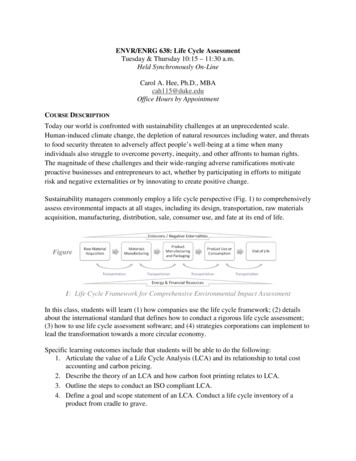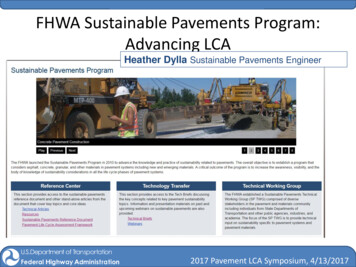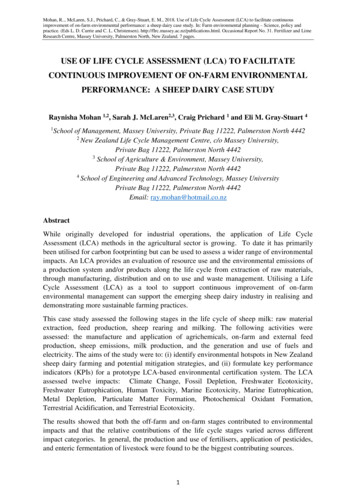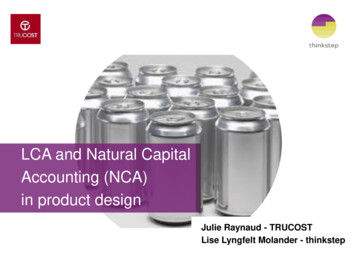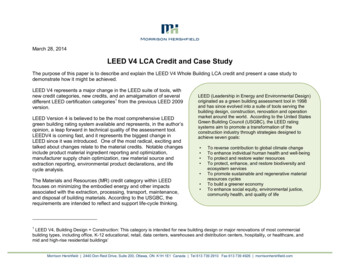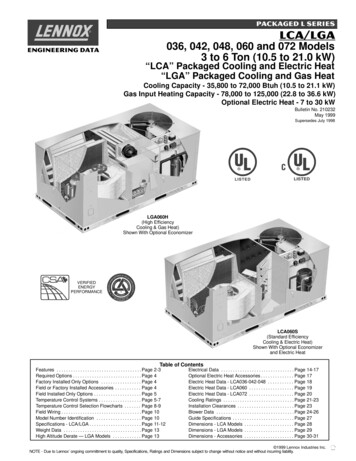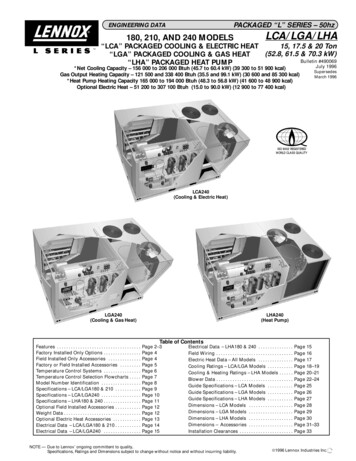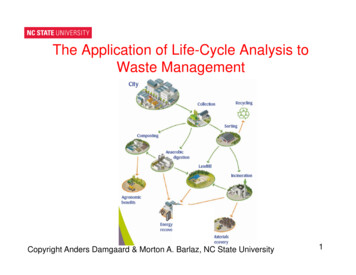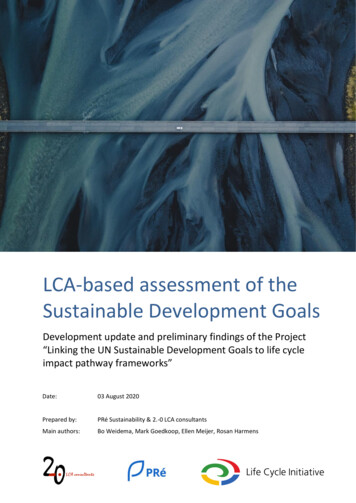
Transcription
LCA-based assessment of theSustainable Development GoalsDevelopment update and preliminary findings of the Project“Linking the UN Sustainable Development Goals to life cycleimpact pathway frameworks”Date:03 August 2020Prepared by:PRé Sustainability & 2.-0 LCA consultantsMain authors:Bo Weidema, Mark Goedkoop, Ellen Meijer, Rosan Harmens
2.-0 LCA consultants and PRé SustainabilityTable of Contents1Introduction . 42Steps for Life Cycle SDG Screening and assessment . 73Life cycle SDG screening . 1043.1Goal and scope definition. 103.2Inventory analysis . 103.3Impact assessment . 143.4Most important learnings. 17Life cycle SDG assessment . 194.1Goal and scope definition. 194.2Inventory analysis . 194.3Impact assessment . 224.4Most important learnings. 265Next steps . 316Acknowledgments . 337References . 358Annexes . 40Annex A: Impact categories included in life cycle SDG screening . 41Annex B: Additional descriptions and definitions of pressure indicators . 43Annex C: Additional examples of impact pathway diagrams . 48Annex D: Example of a full quantified impact pathway calculation. 512
Introduction
2.-0 LCA consultants and PRé Sustainability1 IntroductionIn 2015, all United Nation member states adopted the 2030 Agenda for Sustainable Development,with the 17 Sustainable Development goals (SDGs) at its heart (United Nations, 2019). The SDGsprovide 17 goals, 169 targets and more than 200 indicators to guide governments toward sustainabledevelopment in 2030. The aim is to provide a roadmap and blueprint for a better and moresustainable future for all.Although the goals are mostly defined on government and policy level, the SDGs are relevant forbusinesses as well. Achieving the SDGs can, for example, create business value and jobs (Business &Sustainable Development Commission, 2017). In addition, contributing to the SDGs createsopportunities to better manage risks, anticipate customer demand, secure access to resources andstrengthen supply chains (World Business Council for Sustainable Development, 2017). Consideringthis, it is no surprise that a growing number of companies have communicated that they will aligntheir strategy with the SDGs and have committed to support all or some of the 17 SDGs.Often, commitment to SDGs is communicated on a company-wide level. Reaching the SDG targets,however, depends on the products and services that a company offers. Commitment to SDGstherefore also implies a change in product development and reporting: companies are expected tobe able to use metrics that show if (and if so, how) existing or new products contribute to supportingthe SDGs. While it is already possible to use life cycle assessment (LCA) to assess environmental andsocial impact at the product level, using LCA-based metrics for the SDGs is a new challenge.An important aspect of this challenge is that the SDGs were developed for global and country-levelpolicies, while LCA was developed for assessment on the level of individual products (Kühnen et al.2019). Furthermore, the SDG targets and indicators, as defined by the UN, are often qualitativerather than quantitative. Finally, SDGs may overlap, interact or conflict with each other: SDG 1 (Nopoverty) and SDG 8 (Decent work and economic growth) overlap, while SDG 13 (Climate action) andSDG 7 (Affordable and clean energy) seem to be in conflict (Scherer et al, 2018).Project “Linking the UN Sustainable Development Goals to lifecycle impact pathway frameworks”The project “Linking the UN Sustainable Development Goals to life cycle impact pathwayframeworks” was initiated by the UN Life Cycle Initiative to create robust links between the SDGs andLCA and to develop a methodology for measuring and reporting on companies’ contributions to theSDGs. The project is under administration of OnePlanet and is being executed by 2.-0 LCAConsultants and PRé Sustainability.The project consists of the following aspects: methodology, consultation, and cases. At the time ofwriting, May 2020, the status of these aspects is as follows:Methodology: the outline of the methodology has been developed and applied to a first setof SDGs. The project team is currently working on expanding the methodology to theremaining SDGs.Consultation: A number of public and technical consultation rounds have been held, whichhave provided valuable input. More consultation rounds will follow in the course of theproject.4
2.-0 LCA consultants and PRé SustainabilityCases: the methodology is now being applied and tested in a number of businesses cases.These cases are being executed by business partners that joined the project, supported by2.-0 LCA Consultants and PRé Sustainability. The companies that are now part of the projectare ArcelorMittal, Corbion, and Novozymes.We’re still in an early stage of applying and testing the methodology, so interested companies canstill join the project as business partners.This publication discusses the preliminary findings and details from our deep-dive into how LCA andthe SDGs intersect. The aim is to show specific examples of how the links between LCA and SDGs canbe created and how this information can be used by business. It’s intended for those who want tolearn more about the link between LCA and the SDGs, want to stay up to date of this project, andcompanies that are interested to join and want to learn more.Goals and application contextsCompanies may have different goals and reasons for analyzing or reporting on their contribution tothe SGDs. To accommodate this, this project provides a framework for different types of assessmentin different application contexts. This ensures that the proposed method is flexible enough tosupport different goals while providing enough structure and guidance to achieve those goals.There are two main contexts in which companies want to link the SDGs to environmental and socialLCA (Weidema et al. 2018):1. When companies want to reuse their existing LCA procedures and results but also want tounderstand which products and impact categories generally contribute to which SDGs, a lifecycle SDG screening (LCSS) can link their LCA results to the SDG targets in a qualitative way.2. Companies that desire to go beyond existing LCA indicators and toward a morecomprehensive integration of SDG indicators can do a life cycle SDG assessment (LCSA)instead. Such an assessment quantifies the impact pathways and makes the contributions tothe SDGs comparable by tracing all impacts to the ultimate endpoint of sustainablewellbeing. This allows organizations to calculate how much their product contributes to eachSDG, target and indicator, as well as to overall sustainable wellbeing.Both the screening and the assessment allow organizations to identify SDG hotspots along the lifecycle of the product, and determine how these SDG hotspots can be influenced. Both also result ininformation that can be used to steer sustainability strategies, although on different levels.The rest of this publication elaborates on the application and expected results of the LCSS and LCSA.Chapter 2 starts with the general steps to be taken for both approaches. Chapter 3 describes theLCSS, followed by Chapter 4 on the LCSA. Chapter 5 provides an outlook for the following steps of theproject.5
2.-0 LCA consultants and PRé SustainabilitySteps for lifecycle SDGscreening andassessment6
2.-0 LCA consultants and PRé Sustainability2 Steps for Life Cycle SDGScreening and assessmentThe steps of the SDG screening and assessment are similar to those of a regular LCA study. An LCA, asdescribed in the ISO standards 14040 and 14044 (ISO, 2016a; ISO, 2016b), consists of the followingfour stages, and so do the LCSS and LCSA:1.2.3.4.Goal and scope definitionInventory analysisImpact assessmentInterpretationThis chapter gives a brief overview of the different stages. They will be covered in more detail perapplication context, in chapters 3 and 4.Step 1: goal and scope definitionThe goal and scope stage determines the most important elements of the SDG study, such as thereason for executing the study, a definition of the studied product and its life cycle, and a descriptionof the system boundaries.Possible goals for conducting an SDG study are:-----To understand which SDG or SDGs your product is currently contributing to. This cansupport the development of a (company-wide) strategy for SDG contribution, and the choiceof which SDGs to focus on as an organization.To determine if and how the contribution of your product to certain SDGs has changedover time. This ongoing impact monitoring allows a company to check whether developmentefforts are indeed having a positive impact on the SDGs a company is targeting.To assess how much your product contributes to certain SDGs. This information is valuablefor more detailed monitoring and reporting on SDG progress, as well as for comparingproducts or innovations.To support working toward an increased positive contribution to an SDG or SDGs. Theinformation can show the R&D department how their work affects the company’scontribution to the SDGs, allowing them to focus their efforts on those aspects that mattermost for improving the contribution to the SDGs.To support communication about SDG contribution. The information can be used to back upyour claims regarding SDGs, which strengthens the credibility and trustworthiness of SDGreporting.The goal of the study determines whether you need an SDG screening or a full SDG assessment. It’salso possible to follow both approaches. For example, starting with an SDG screening and then divingdeeper into relevant parts of the product life cycle with the assessment.Other aspects to determine in the goal and scope phase are the target audience and the datacollection strategy.7
2.-0 LCA consultants and PRé SustainabilityStep 2: inventory analysisDuring the inventory analysis stage, all required information about the product system under study iscollected. The exact data needs vary, depending on the goal. Similar to regular LCA, ambitions fordata quality will affect the required workload and the reliability of the results (Baumann & Tillman,2004). An SDG screening approach, which is qualitative, uses the results of both an environmentaland a social LCA. This data is then converted to a 5-point scale. For an SDG assessment, which isquantitative, more elaborate data has to be collected about the life cycle of the product. Thisincludes data beyond the scope of regular environmental and social LCAs.A data collection guideline is under development to assist organizations with this stage of the study.The guide is intended to include detailed definitions of the required data, how it should be collectedand measured, and how to translate the data to the format required for the study. This guidance willbe tested in practice by the project partners when collecting the data for their SDG case study.Step 3: impact assessmentIn the impact assessment stage, the data that is collected in the previous stage is translated intomeaningful impact information that can support companies in their decision-making. The screeningmethod will translate the input data into scores that show whether the product under studycontributes to an SDG or not. Once the methodology is complete, it will contain all the necessaryinformation to make this translation. The assessment method will use cause-effect relations totranslate the inventory data into impact scores on midpoint and endpoint level. The impact pathwaysthat are needed for this step are being developed within this project, as well as the characterizationfactors needed to calculate the results.Step 4: interpretationIn this final stage of the SDG analysis, the results are used to answer the stated goal. To determinethe validity and robustness of the results, this stage also includes an assessment of data quality, anuncertainty determination and a reflection on the limitations of the study.If communication of the results was part of the goal, the possibilities and limitations ofcommunicating the results are investigated in this stage as well. More specific guidance oninterpretation and communication of the results is provided in the chapters about the two differentapplication contexts.8
2.-0 LCA consultants and PRé SustainabilityLife cycle SDGscreening9
2.-0 LCA consultants and PRé Sustainability3 Life cycle SDG screeningThis chapter provides more detail about SDG screening. As described in the previous chapter, thefirst step of any SDG study is to define the goal. The SDG screening is suitable for SDG studies wherethe goal is:-To determine which SDGs your product is contributing toTo monitor qualitative changes in the contribution of your product to the SDGs over timeTo support qualitative claims about SDG contributionTo provide product developers with qualitative information that allows them to work towardimproved SDG contributionThis list is not exhaustive, but it communicates the essence: the SDG screening approach can be usedto make a qualitative analysis of a product to determine if it may potentially be a detriment or abenefit to one or more SDGs. It is important to stress the word potentially: since this is a screeningmethod, there are inherent limitations to robustness and detail.The SDG screening approach provides results on two levels:1. For each of the Sustainable Development Goals2. For each of the targets of each Sustainable Development GoalThese results are provided on the following spectrum:-The contribution is potentially beneficialThe contribution is neither clearly beneficial nor detrimentalThe contribution is potentially detrimentalIf the goal requires a more elaborate and quantified understanding, an SDG assessment is bettersuited to achieve that understanding (see chapter 4).If the goal of your study fits the SDG screening application, the next step is to define the scope.Because SDG screening is based on the results of a social and environmental LCA, the goals of theseunderlying studies need to be sufficiently similar to the goal and scope of the SDG study.The goal and scope definition of the SDG screening should contain the same elements as that of aregular LCA. This means that, for instance, the functional unit, product under study and systemboundaries should be defined in this stage. In addition, a reference product should be determined(see section 3.2.2).After these traditional LCA elements are defined, the SDGs that will be considered in the studyshould be determined. Which and how many SDGs you should include in the study depends on thegoal. If the goal is to understand which SDGs a product contributes to, all SDGs need to be includedin the scope. But perhaps only a subset of the SDGs are relevant. A materiality assessment candetermine the most relevant SDGs to consider, whether for your company in general or for thespecific product.The SDG screening approach uses the results of an environmental and a social LCA to determinewhether a product contributes to the SDGs and their targets. For the purposes of this project, the10
2.-0 LCA consultants and PRé SustainabilitySDG screening method is based on the ReCiPe 2016 method for environmental impact assessment(Huijbregts et al., 2016) and the Product Social Impact Assessment Handbook 2019 method for socialimpact assessment (Goedkoop et al, 2018). An overview of the impact categories included in thesemethods is presented in annex A. An interesting task for future method development team would beincluding additional impact assessment methods or indicators.This inventory analysis step consists of collecting results from or executing new environmental andsocial LCA studies of the product, plus an environmental LCA study of a benchmark product (seesection 3.2.2). If pre-existing studies are used, it is critical to pay attention the goal and scope ofthese studies – they should be compatible with each other and with the goal and scope of the SDGscreening.Once compatible environmental and social LCA studies have been identified or performed, theresults for each impact category in scope need to be listed on a 5-point scale, as illustrated in Table3-1. The details of the scale are further defined per type of impact (social or environmental).Table 3-1: Structure of the 5-point scale 2Performance is a lot better than the benchmark 1Performance is better than the benchmark0Performance is equal to the benchmark-1Performance is worse than the benchmark-2Performance is a lot worse than the benchmarkThe impact assessment method used for social LCA in this project, product social impact assessment,already presents the results on a compatible 5-point scale, as illustrated in Table 3-2. The scale isbenchmarked against compliance with local laws or alignment with international standards, where ascale of 0 means the product or company is in compliance. A more specific scale exists for each socialimpact category. An example is shown in Table 3-3, which shows the scale for health and safety ofworkers plus the relevant performance indicators (see also table 3-4).Table 3-2: Generic structure of the 5-point scale in the Product Social Impact Assessment Handbook(Goedkoop et al, 2018) 2Ideal performance; beneficial output achieved and reported 1Progress beyond compliance is made and monitored0In compliance with local laws or aligned with international standards-1Non-compliant situation, but actions to improve have been taken-2No data or non-compliant situation; no action taken11
2.-0 LCA consultants and PRé SustainabilityTable 3-3: 5-point scale for health and safety of workers, from the Product Social Impact Assessment Handbook(Goedkoop et al, 2018)Performance reference scalesRelated performanceindicators1 or 2-3 2The company has a PDCA process in place to pro-actively protect workers’health and safety. (Beyond compliance with local laws.) Companycommitments and progress on occupational health and safety are disclosedpublicly. The top management of the company has publiclydeclared/recognized health and safety of workers as key priority and thecompany aims to be the best in class. 1The company has a PDCA model in place to pro-actively protect workers’health and safety. (Beyond compliance with local laws.)1 or 2-3Sufficient evidence indicates compliance with health and safety standards orlocal laws10ORand 5-7and 5or2-3The occupational health and safety of workers is monitored, and workers haveaccess to all the required personal protective equipment.-1-2Evidence indicates that the company does not comply with health and safetystandards, and a corrective action plan with a clear timeline for completionhas been developed.4Evidence indicate that the company or facility does not comply with healthand safety standards or local laws but a corrective action plan with a cleartimeline for completion has not been developed-ORNo data is available.The score on this scale is determined by looking at performance indicators, which are specific to eachimpact category. Table 3-4 shows the performance indicators used to determine the score of theproduct with regards to health and safety of workers. A full list of the performance reference scalesand performance indicators for all impact categories can be found in the Product Social ImpactAssessment Handbook (Goedkoop et al, 2018). An SDG study requires the performance level results,on the 5-point scale, for all impact categories and life cycle stages that are in scope.Table 3-4: Performance indicators for health and safety of workers from the Product Social Impact AssessmentHandbook (Goedkoop et al, 2018)#Performance indicators1The company or facility complies with health and safety standards or local laws.Type of evidence required: License to operate, certification schemes/standards on health and safety, audits, etc. The company or facility has conducted a health and safety risk assessment.2Workers have access to all the required personal protective equipment.3The occupational health and safety of workers is monitored.12
2.-0 LCA consultants and PRé Sustainability4In a case of non-compliance with health and safety standards or local laws, the company or facility hasdeveloped a corrective action plan with clear timeline for completion.5The company has a PDCA model in place to pro-actively protect workers’ health and safety, beyondcompliance with local laws.*Please note that the table below displays only examples of supporting evidence that can be provided tothis question.Supporting evidenceEducation & training onExamples:health and safety Average hours of training per year per employee per category.Appointed personnelExamples: In each department, an employee is appointed as health and safetyofficer. Personnel assigned to monitor/train/etc. workers on health and safetyissues.Records of safetyincidentsExamples: Rate of total recordable injuries and illnesses per million working hours. Frequency index of recordable injuries per 100 employees. Total number of fatalities. Rate of lost-time injuries and illnesses.6Company’s commitments and progress on occupational health and safety are disclosed publicly (toexternal stakeholders).7The top management of the company has publicly declared/recognized health and safety of workers askey priority and the company aims to be the best in class.To apply the results of the social LCA in the SDG screening, it is necessary to aggregate the score persocial impact category over the different life cycle stages. This aggregation is not part of themethodology described in the Product Social Impact Assessment Handbook, because aggregation isstill a point of discussion in the field of social LCA. To make the results usable for the SDG screening,the project team is exploring several options, such as aggregation based on the added value orworking hours of each supply chain step. For now, this aspect is still a point of further development.The impact assessment method used for environmental LCA in this project, ReCiPe 2016, presentsquantitative results with a different unit for each impact category. Unlike with the social LCA results,it is not possible to benchmark the studied product against compliance with the laws or regulations.A different benchmarking approach is needed.Different ways of benchmarking are described in the literature, each with their own implementationchallenges. In environmental LCA, it is common to compare multiple products that fulfill the samefunction, so the different products serve as a reference or benchmark for each other. Another optionis to use a representative product or a sector average as a reference. Both of these methods are used13
2.-0 LCA consultants and PRé Sustainabilityin the European product environmental footprint guidelines (European Commission, 2017). A moreholistic approach is to use an absolute sustainability target as a reference, for example the planetaryboundaries framework (Rockström et al, 2009). All benchmark options come with their ownlimitations and implementation challenges. For example, defining a representative product ordeveloping a sector average require time and the cooperation of sector stakeholders. Absolutesustainability targets only exist for a limited number of impact categories and often come with largeuncertainties. The fluctuation in these targets, depending on the chosen method and inherent valuebased choices, can be in orders of magnitude (Sandin et al, 2015).In this phase of the project, the method requires a benchmark that can be applied directly to allReCiPe impact categories and that works for all types of products. For this reason, SDG screeningstudies require a reference product to determine the performance on the 5-point scale. Defining thisreference product is part of the goal and scope definition of the SDG screening. A good candidate fora reference product is the previous version of the product under study: an internal benchmark. If theproduct is completely new and no internal predecessor exists, a readily available generic productwith the same function can be considered as external benchmark.Table 3-5 shows the generic structure of the 5-point reference scale for the environmental analysis.The given percentages are a first iteration; the applicability will be tested with the business cases.Table 3-5: The 5-point scale for environmental impact categories 2The environmental impact is a lot lower than the reference product ( 10%) 1The environmental impact is significantly lower than the reference product (5 to 10%)0There is no significant difference in environmental impact-1The environmental impact is significantly higher than the reference product (5 to 10%)-2The environmental impact is a lot higher than the reference product ( 10%)As a consequence of using a reference product as a benchmark, any identified contribution to theSDGs is always in relation to this reference product, and should be communicated as such. A positivescore on the 5-point scale indicates a step in the right direction, but does not necessarily mean thatthe product is sustainable on an absolute basis, or that there are no better alternatives available. Forexample, an improved coal energy plant could, according to this method, deliver a beneficialcontribution to the SDGs compared to its less sustainable predecessor. But compared to renewableenergy sources, coal may still be a very unfavorable energy source. Therefore, both the reason forusing the chosen reference product and the resulting limitations need to be clearly described in theSDG screening results. Development of a more absolute benchmark will be considered in futurephases of the project.The inventory assessment for the environmental impact categories results in a score on the 5-pointreference scale for each of the impact categories included in the analysis. These scores, togetherwith the social scores, form the input for the impact assessment step that is elaborated in the nextsection.In the impact assessment step of the SDG screening, it is evaluated if and how the social andenvironmental LCA impact categories contribute to the individual targets of each SDG. This linking ofthe impact categories to the SDG targets through classification and characterization is the main focus14
2.-0 LCA consultants and PRé Sustainabilitypoint of this project, as this is where the connection between LCA results and a possible contributionto the SDGs is made.Text box 1: Classification and characterization step of the SDG screening.To develop the LCA screening methodology, the project team looked at each SDG targetand followed two steps: classification and characterization.1. Classification: is there a relation between the LCA impact category and the SDGtarget?This is answered after careful analysis of the SDGs, their targets and indicators, andthe environmental and social impact categories. Only strong links are included.Where necessary, the analysis is complemented with expert judgment.2. Characterization: what is the nature of the relation between the LCA impactcategory and the SDG target? This step determines the score needed to qualify as acontribution to a target, per target and impact category. For example, in somecases only scores of 2 will be considered a contribution, while in other cases ascore of 1 will already qualify as a contribution. Similarly, in some cases a score of-1 or -2 may be considered detrimental for that target, while in other cases thesescores would be considered as neutral. As in the classification step, these links arebased on detailed analysis and expert judgment.The outcomes of these two steps were used to create the tools for impact assessment.The following tools are needed to complete the impact assessment:1. An overview for every SDG, illustrating the links between the social and environmental LCAimpact categories and the SDG targets. Figure 3-1 is an example of such an overview,showing the links between a number of LCA impact categories and SDG6 (Clean water an
LCA (Weidema et al. 2018): 1. When companies want to reuse their existing LCA procedures and results but also want to understand which products and impact categories generally contribute to which SDGs, a life cycle SDG screening (LCSS) can link their LCA results to the SDG targets in a qualitative way. 2.


